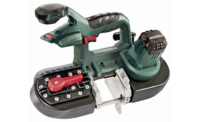
Safety standards for table saws may soon get more stringent in the state of California. A bill under consideration in the state Legislature would require "injury-mitigation technology" to be built into every table saw sold in the state starting in 2016.
The bill, AB 2218, was introduced by Assemblyman Das Williams (D-Santa Barbara) and was passed by the state Assembly in May by a 64-4 vote. The measure is now in the state Senate and would require concurrence from the state Assembly before going to the governor.
The injury-mitigation measures proposed in AB 2218 bear a strong resemblance to technology produced by Tualatin, Ore.-based SawStop LLC, which uses a sensor to stop a table saw's blade when it comes in contact with flesh or a similar electric conductor. Invented by Dr. Stephen Gass in 2003, SawStop saws can shut off milliseconds after contact is made with an operator's hand or fingers.
Opponents of the bill maintain the specificity of the new law would grant an unfair advantage to SawStop. In a June 1 letter addressed to Assemblyman Williams, the California Chamber of Commerce stated that "the bill fulfills a decade-long attempt by one company to create a monopoly, and the financial rewards thereof, for a technology this single company essentially owns through a network of patents." The California Chamber of Commerce represents the California Manufacturers & Technology Association as well as major power-tool retailers Home Depot and Lowe's.
"Saying we have a monopoly is very disingenuous," said David Fanning, co-founder of SawStop. "They have patents on their own technology." While he notes that AB 2218 was originally sponsored by SB3, SawStop's parent company, Fanning contends the lack of similar safety offerings from other table-saw makers is a deliberate choice. "We were three guys in a barn. To say that multimillion-dollar companies can't develop this is absurd," he said.
The bill has undergone several revisions since its introduction. In its current form, the bill calls for technology "to prevent or detect contact with, or dangerous proximity between, a hand or finger and the teeth of the blade above the tabletop of a table saw, and to prevent the blade from causing severe injury to the hand or finger." Language that specified prevention of cuts to the hand or finger deeper than 1/8 in. was removed in a revision.
New rules on table-saw safety are also under consideration at the federal level. The Consumer Product Safety Commission (CPSC) held hearings in 2011 on SawStop, with an extended comment period that ended in March 2012. According to a CPSC log of a March 2011 meeting, the Power Tool Institute, an industry lobbying group, said the cost of the technology would "force the low-end table saw out of the market."
Cost is an issue with the injury-mitigation technology. According to PTI, consumer table saws have a median price of $160; the safety technology would add $150 to the price. SawStop's Fanning has said the components for the technology cost about $55 to $75 and cannot be retrofitted to existing saws. When the SawStop mechanism is tripped, a $69 single-use cartridge must be replaced.
AB 2218's supporters take a broader view of cost. "The unfortunate thing is that severe table-saw injuries continue to occur even though technologies exists to prevent almost all of them. These injuries cost society billions annually," said Assemblyman Williams. "This bill does not specify the exact kind of injury-mitigation technology and in no way prohibits companies from developing their own. This type of technology is urgently needed for safety."




